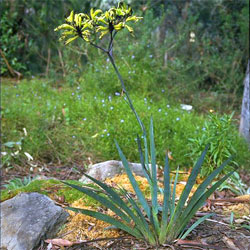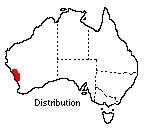Macropidia fuliginosa
 |
 |
Black Kangaroo Paw
Macropidia fuliginosa (Hook.) Druce
Macropidia fuliginosa, commonly known as the Black Kangaroo Paw, is a striking black and lime-green flowered plant, which is distinctly different from the more commonly grown Anigozanthos Kangaroo Paws. Black and green flowers are extremely rare in Australian plants, so Macropidia makes a most attractive addition to native gardens. Growing it however, is likely to be a challenge in the eastern states.
Macropidia is part of the family Haemodoraceae which it shares with Anigozanthos. The two genera are believed to have evolved in the south-west of Western Australia from a common Gondwanan ancestor. M. fuliginosa is the only species in the Macropidia genus. It is sufficiently different to the Anigozanthos species that attempts at hybridisation have so far been unsuccessful.
 The
natural range of Macropidia is in the south-west of Western Australia.
It occupies different habitat to the other Kangaroo Paws, preferring gravelly
lateritic soils. It is found in a belt of low heath and mallee communities,
slightly inland, which runs from just north of Perth to just south of Geraldton.
The
natural range of Macropidia is in the south-west of Western Australia.
It occupies different habitat to the other Kangaroo Paws, preferring gravelly
lateritic soils. It is found in a belt of low heath and mallee communities,
slightly inland, which runs from just north of Perth to just south of Geraldton.
Macropidia is a perennial, rhizomatous, monocotyledon, quite unassuming outside of the flowering season. During flowering however, it is spectacularly transformed, reaching heights of 0.6m - 1.8m. Flowering occurs between July and December and plants may live for 30 years.
Growing Macropidia will present a challenge for gardeners in the eastern states of Australia. The plant requires a narrow range of growing conditions and is susceptible to pests and diseases. To offset the difficulties, there is an enormous body of horticultural information developed for the cut flower industry. It is probably best to grow Macropidia in a pot to allow flexibility in siting the plant. It grows best in full sunlight and prefers warm to hot conditions. Siting it in front of a north-facing wall will help create a suitable microclimate and protect it from frost. Soil should be well drained. Like the other Kangaroo Paws, Macropidia will achieve maximum growth and flower production when well watered. A drip irrigation system is recommended because the plant will suffer if it is allowed to dry out and conversely, does not like waterlogging. Macropidia responds well to fertilisation, but is susceptible to phosphate toxicity. Fertilisers designed for Australian native plants are best.
Macropidia is susceptible to some pests and diseases. A particular problem is the fungal disease Ink Spot which appears as a blackening of the leaves. To prevent Ink Spot, avoid wetting the leaves when watering, especially in autumn and winter. Pruning after flowering may also help. Snails can be serious pests of young plants so putting a couple of pellets in the pot is a good idea. Propagation is easiest from a rhizome although seed is also available from nurseries. Rhizomes can be divided but the results are variable. Macropidia can be successfully grown from seed. No pre-treatment is necessary but it is difficult to germinate. Smoke water treatment may help.
Text by Adam Leavesley (2002 Student Botanical Intern)
Name meaning: Macropidia fuliginosaMacropidia - from the Greek macros 'large' and podes 'foot', referring to the kangaroo genus Macropus. fuliginosa - from the Latin fuligo 'soot' referring to the black colouration. |
References
Association of Societies for Growing Australian Plants. 2002. Seeds. http://farrer.csu.edu.au/ASGAP/seed.html
Elliot, W.R. & Jones, D.L. 1993. Encyclopaedia of Australian Plants Suitable for Cultivation. Lothian. Melbourne.
Hopper, S.D. 1993. Kangaroo Paws and Catspaws: A Natural History and Field Guide. Department of Conservation and Land Management, Perth, Western Australia.
Johnson, K.A. & Burchett, M. (eds) 1996. Australian Native Plants. University of New South Wales Press, Sydney.
![An Australian Government Initiative [logo]](/images/austgovt_brown_90px.gif)

